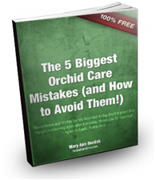 Many people love to own multiple orchids especially after they’ve witnessed the truly brilliant blossoms on their first plant. As a result, people generally have several different orchids, and not all are the same type. When caring for orchids, especially those of different types, it is essential to understand what each orchid needs so you can adjust the climate accordingly and water it at appropriate times.
Many people love to own multiple orchids especially after they’ve witnessed the truly brilliant blossoms on their first plant. As a result, people generally have several different orchids, and not all are the same type. When caring for orchids, especially those of different types, it is essential to understand what each orchid needs so you can adjust the climate accordingly and water it at appropriate times.
Unfortunately, even the most experienced orchid growers will have a situation where a single orchid will begin to die while the others are thriving. In this case, it is essential to find out exactly what is causing it to die, if that cause can affect the others, and how to fix it!
Discovering The Cause
First off, you need to begin a process of elimination to find out what exactly is causing the issue. Once you know what is causing that single plant to die while the others are fine, then you can begin rectifying it and taking preventative measures to stop it happening again in the future.
Different Types/Different needs
One problem that people have with orchids is that they own different types of orchids. While orchids generally like warm, humid places, there are some species that are much more sensitive and that prefer slightly different climates. Below are four main household orchid species with their general climate needs:
Phalaenopsis orchids – These are the main orchids that you generally see at grocery stores. They have long, elegant stems and prefer to grow in a pot with plenty of drainage. They enjoy watering every 7-10 days and prefer to be left in a windowsill with moderate amounts of sunlight each day.
Dendrobium orchids – These orchids are a bit fussier and will lose their leaves and blooms if the temperature drops below 60 Fahrenheit. This means that you need to keep them in a much warmer environment and allow them to have plenty of humidity.
Slipper orchids – These beautiful yet strange orchids are quite difficult to grow for beginners because they need to be in quite strict environments. Keeping a strict humidity level and giving them appropriate sunlight each day can be difficult even for experienced growers!
Cymbidium orchids – These are large beautiful orchids that have tons of flowers on them and look fabulous inside and out. Some lucky gardeners can enjoy the cymbidium orchids outside and in abundance; however, others need to have specific growing conditions inside to keep them alive. Fortunately they are fairly easy to grow once you get the right potting mix for it!
If you are mixing up different types of orchids and you have one particular plant that is dying, then consider reevaluating the conditions you have that specific orchid plant in as it may not be suitable for its type which is why it is dying!
Potting Conditions
Another reason that one particular orchid may be dying is the conditions. Many people do not allow for enough drainage which can easily lead to diseases and rot. Another potting issue people have is with bark. Bark eventually becomes soil after so long which is why it is recommended to change it once a year. Orchids dislike soil as it absorbs water. If your one plant is dying, then check its potting mixture and make sure it is up to par!
Disease/Rot
Depending on your orchids and their health, there is a good chance that the one orchid that is dying could be suffering from some type of disease or even rot. If a plant was recently moved or has gone through some type of shock or blooming, then it is more susceptible to disease and rot.
Recent Purchase
If your dying orchid is a recent purchase that you bought within the past two or three months, then it may not be entirely your fault that it is dying, so don’t fret! Often times stores will pack the orchids into pots that have too much moss and will water them too frequently. Since orchids really only sell when they are blooming, the orchids are spending most of their resources on the bloom and are vulnerable to infection and rot while at the stores. Additionally, the transportation process can be equally as stressful, meaning that your poor orchid could be already in shock by the time you get it home.
If your new orchid is not entirely shocked as soon as you get it home, that does not mean it is not susceptible to infections. It will likely bud blast, drop the blooms, and be in a weakened state. This means that it is highly susceptible to infections so make sure to treat it with some diluted fertilizers, ensure it has proper potting, and allow it to recover without over watering it!
Have you had one of your orchids struggle while your others thrived? What did you do? Leave a comment below and tell us about it!
To figure out if your orchid has a disease, read how to know if your orchid is sick.




I have kept orchids for approx. 4 years now and up to 3 months ago had never lost one plant.In the last 3 months I have lost 3 plants ,all the leaves drop off gradually leaving a good green root system and a stump of the trunk.I feed them once a week adding an appropriate mix of (baby bio)orchid food .I have approx. 20 plants and the rest are fine (some in flower now) my son (who also keeps orchids says its Stem Rot? can you help please Regards Colin Cook
Hi Colin – I’m sorry that you are having these struggles. This is a helpful article – pay attention to the sphag and bag method at the bottom. We will be doing a post about that soon as well. Thanks! Root rot treatment – Mary Ann